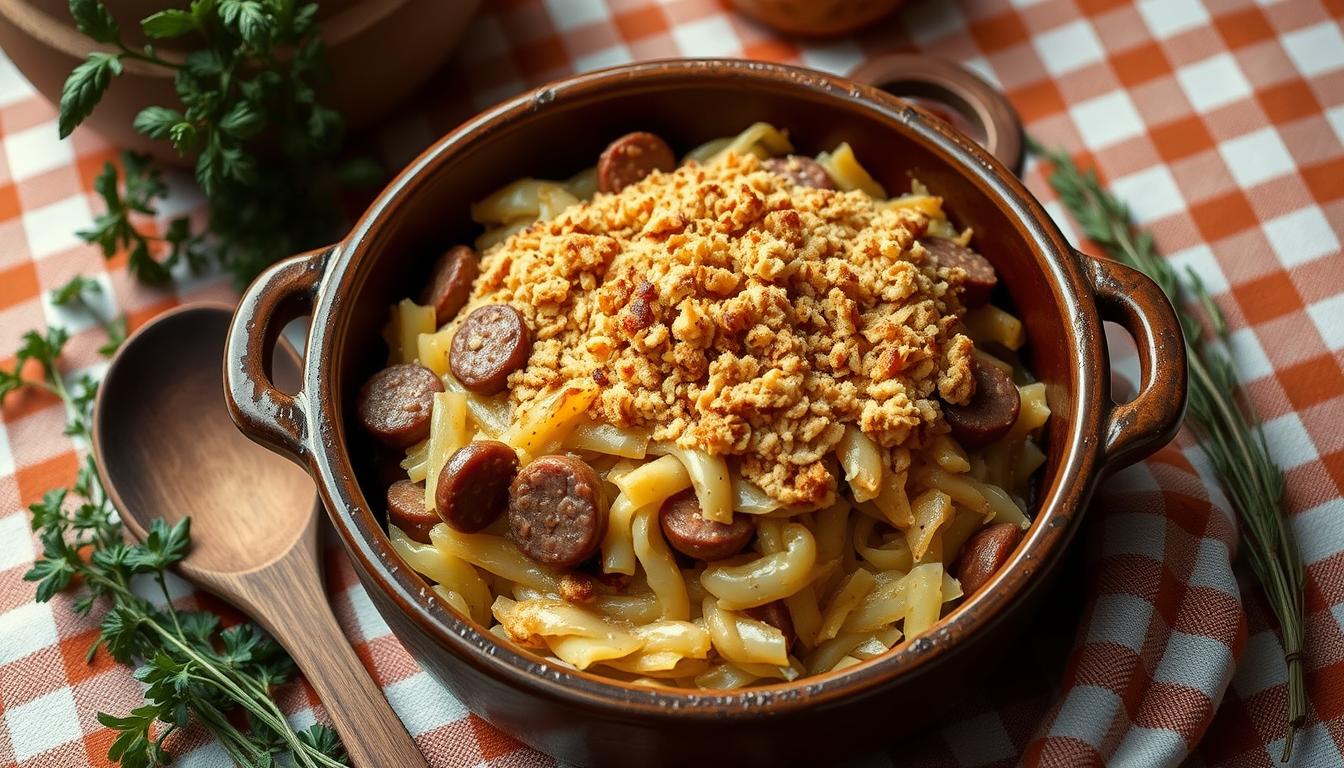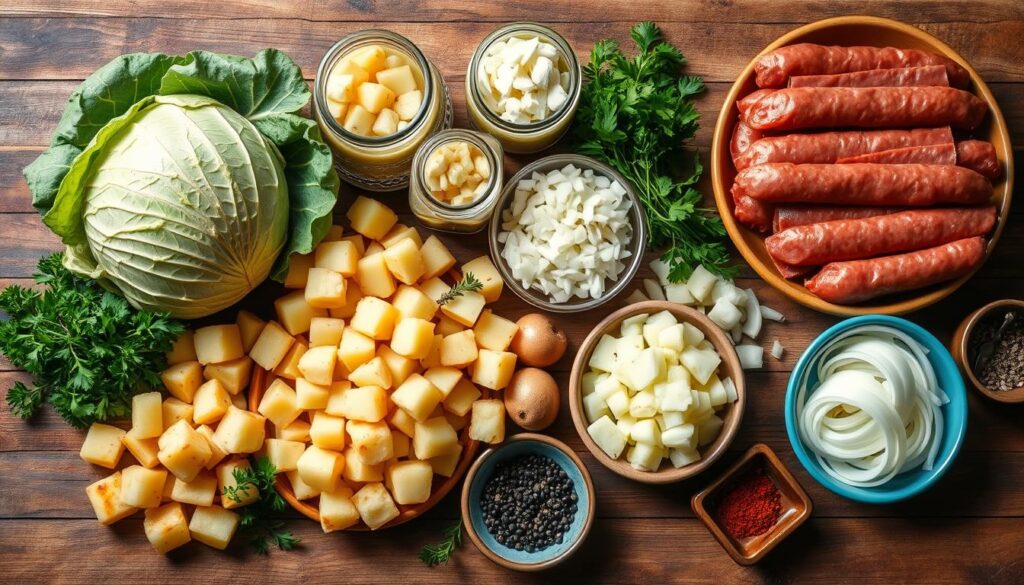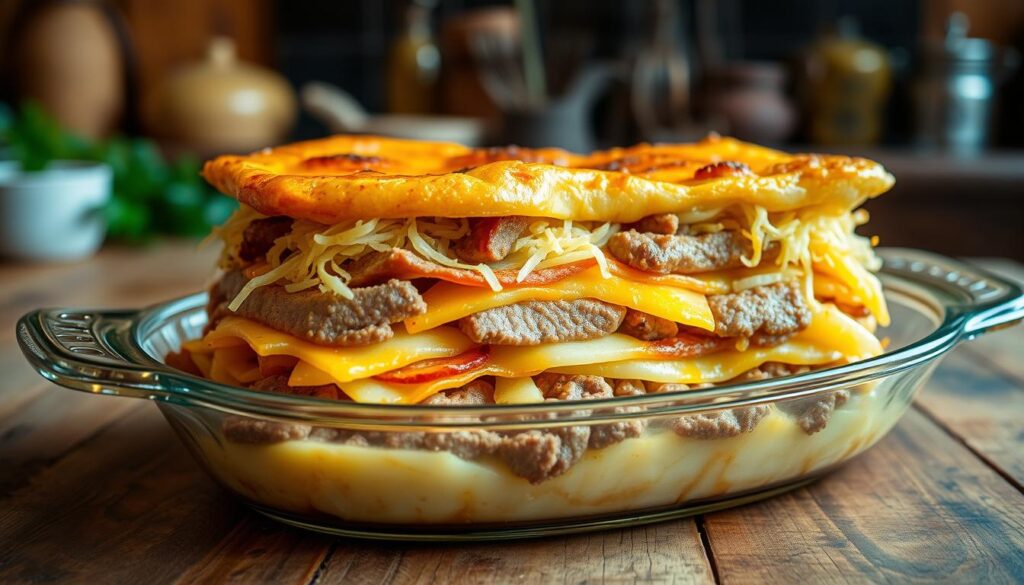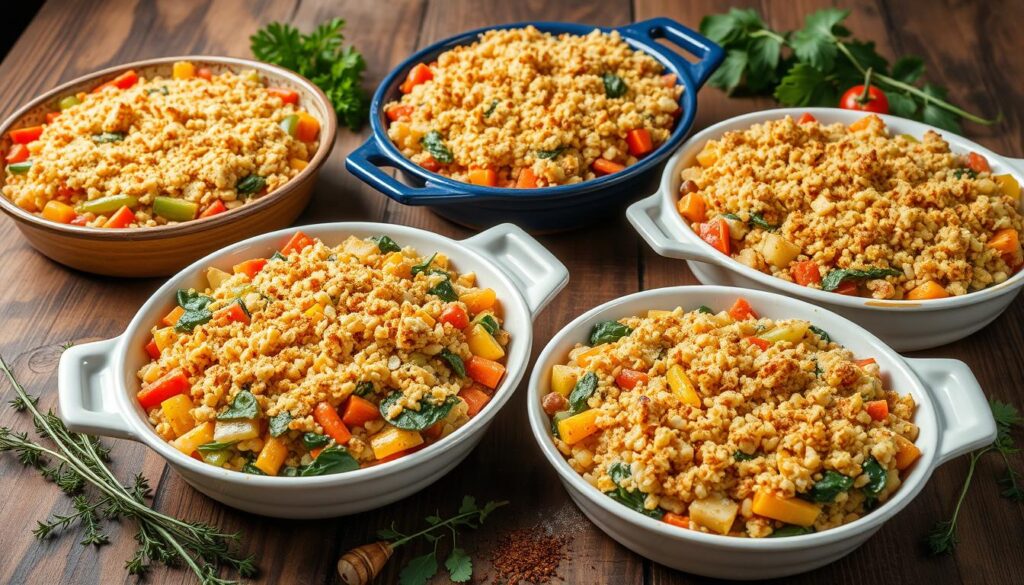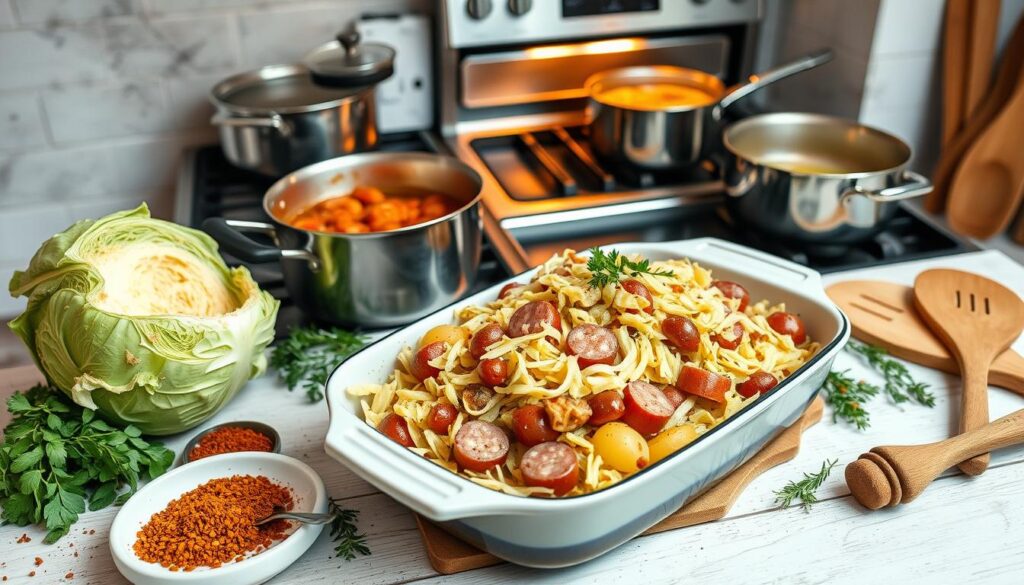Growing up in a Midwestern kitchen, I learned that some recipes are more than just food. They’re memories wrapped in warmth and tradition. The sauerkraut casserole is one such dish. It embodies the heart of German cuisine, turning simple ingredients into a comfort food masterpiece.
When winter winds howl and families gather close, this hearty sauerkraut casserole becomes more than a meal. It’s a culinary embrace. Rooted in German cooking traditions, it combines tangy sauerkraut with rich meats and cheeses. This creates a symphony of flavors that speaks directly to your soul.
Imagine a casserole that brings together the probiotic-rich sauerkraut – packed with just 27 calories per 100 grams – and hearty ingredients like ground beef and Swiss cheese. It’s a low-calorie comfort food that doesn’t compromise on taste or nutrition. Perfect for those seeking both flavor and wellness in their meals.
The magic of this sauerkraut casserole lies in its simplicity. With standard preparation in a 9×13-inch baking dish and a cooking time of 30-45 minutes, you can create a meal for 4-6 people. It’s ideal for family gatherings or cozy weeknight dinners.
What is Sauerkraut Casserole?
Sauerkraut casserole is a tasty trip through German cabbage recipes. It mixes the tangy taste of fermented foods with warm cooking methods. These methods have been loved for generations.
A Brief History of Sauerkraut: sauerkraut casserole
Sauerkraut was a smart way to keep cabbage fresh before refrigerators. German people learned to ferment cabbage. This made it tasty and healthy, lasting through cold winters.
- Originated in China over 2,000 years ago
- Brought to Europe by trade routes
- Became a staple in German cuisine
Origins of Casseroles in German Cuisine: sauerkraut casserole
German cooking focuses on big, satisfying meals for families. Casseroles were a smart way to mix many ingredients into one tasty dish.
| Culinary Characteristic | German Casserole Feature |
|---|---|
| Primary Ingredient | Sauerkraut |
| Typical Meat | Pork or Sausage |
| Cooking Method | Slow Baking |
| Flavor Profile | Rich and Tangy |
“Sauerkraut is not just food, it’s a celebration of preservation and flavor!” – Traditional German Cook
Learning about sauerkraut casserole is like diving into a world of traditional recipes and fermented foods. Every bite shares a tale of creativity and keeping traditions alive.
Key Ingredients for Your Casserole
Making a delicious sauerkraut casserole begins with picking the right ingredients. It’s great for potluck or a cozy family dinner. Knowing the essential parts is key to a tasty dish.
The Role of Sauerkraut
Sauerkraut is the main attraction in this dish. It adds a tangy, complex taste that makes side dishes special. Choose fresh, high-quality sauerkraut for the best flavor.
Choosing the Right Meats
The meat you pick can change your casserole. Here are some classic choices:
- Kielbasa sausage
- Smoked ham
- Ground beef
- Bacon bits
Essential Seasonings and Spices
These ingredients add amazing flavors to your casserole:
- Garlic powder for depth
- Paprika for warmth
- Black pepper
- Caraway seeds
“The secret to a great sauerkraut casserole lies in balancing bold flavors and quality ingredients.”
A serving has 188 calories, 8g of fat, and 8g of protein. It’s quick to make, with just 20 minutes of prep. It’s ideal for those who want to cook something special without spending a lot of time.
How to Prepare Your Casserole
Making a great sauerkraut casserole needs careful steps and layering. This dish is a comfort food classic. It combines tasty ingredients into a warm, soulful meal.
Step-by-Step Preparation Guide
Here’s how to make your casserole:
- Drain sauerkraut well, getting rid of extra liquid
- Cook ground meat and onions in a skillet for about 10 minutes
- Partially cook noodles for 4-6 minutes
- Layer ingredients carefully in your casserole dish
Tips for Layering Ingredients
Layering is key for the right texture and taste. Here’s how to layer your casserole:
- Begin with a layer of drained sauerkraut (30-35% of the dish)
- Add browned meat evenly over the sauerkraut
- Put cheese between layers for extra flavor
- Finish with a layer of cheese on top
Cook at 350°F for about 30 minutes. Let it rest for 5 minutes before serving. This lets the flavors mix well.
“The secret to a great casserole is in the layers and patience during cooking” – Traditional German Home Cook
| Ingredient | Quantity | Preparation Time |
|---|---|---|
| Sauerkraut | 1 pound | 10 minutes |
| Ground Meat | 1.5 pounds | 10 minutes |
| Cheese | 1/2 pound | 5 minutes |
Pro tip: Keep your vegetable-to-protein ratio at 2:1 for the best texture and nutrition.
Variations of Sauerkraut Casserole
Exploring sauerkraut casseroles opens a world of creativity. Whether you love veggies or meat, you can make this dish your own.
Vegetarian Casserole Delights: sauerkraut casserole
Vegetarian casseroles are just as tasty as meat ones. Try these plant-based options:
- Mushroom and lentil base for hearty texture
- Roasted cauliflower as a protein-rich substitute
- Tofu crumbles seasoned with smoky spices
- Quinoa and cabbage recipes for added nutrition
Meat Lover’s Flavor Combinations: sauerkraut casserole
Meat lovers will find endless options in sauerkraut casseroles. Here are some tasty mixes:
- Smoked sausage and ground beef blend
- Kielbasa with crispy bacon pieces
- Cubed ham and pulled pork mix
Unique Flavor Add-Ins
Add these creative ingredients to your casserole:
- Diced apples for a sweet contrast
- Caraway seeds for authentic German flavor
- Aged Swiss or sharp cheddar cheese
- Caramelized onions for depth
“Cooking is about passion, creativity, and the joy of experimenting with flavors!” – Unknown Chef
The beauty of sauerkraut casseroles is their versatility. Feel free to mix ingredients to make your perfect dish!
Cooking Methods for Sauerkraut Casserole
Learning how to cook a sauerkraut casserole is key to making it delicious. The right cooking method can take your dish from good to great. It ensures the flavors are rich and the texture is just right.
Oven-Baking: The Classic Approach
Oven-baking is the traditional way to make sauerkraut casserole. Here are some important tips:
- Preheat your oven to 350°F
- Use a 2-1/2-quart baking dish for the best results
- Bake for about 1 hour
Slow Cooking: A Convenient Alternative
Slow cookers are a great choice for making sauerkraut casserole. They let the ingredients blend together, creating deep flavors with little effort.
“Slow cooking turns simple ingredients into a remarkable meal that feels like home.” – Traditional German Cooking Expert
Tips for Perfect Cooking Times
To make a perfect sauerkraut casserole, pay close attention to these details:
- Prep time: 10 minutes
- Cooking time: 50-60 minutes
- Total time: About 1 hour
| Cooking Method | Temperature | Duration |
|---|---|---|
| Oven-Baking | 350°F | 1 hour |
| Slow Cooker | Low Setting | 6-8 hours |
Pro tip: For the best flavor, use raw fresh sauerkraut. Try different sausages like German or Polish for a unique taste.
Serving Suggestions
Make your sauerkraut casserole even better with the right side dishes and drinks. These choices can turn a simple meal into a memorable one. The perfect pairings can elevate your dining experience.
Perfect Side Dishes to Complement Your Casserole
Choosing the right sides can really boost your sauerkraut casserole’s taste. Here are some great options:
- Crusty German bread for soaking up delicious sauce
- Crisp green salad with light vinaigrette
- Roasted root vegetables
- Buttered egg noodles
- Potato salad with fresh herbs
Ideal Beverage Pairings
Finding the perfect drink can take your meal to the next level. German drinks are perfect for pairing with your casserole:
| Beverage Type | Recommended Options |
|---|---|
| Alcoholic Drinks | Pilsner, Hefeweizen, Riesling wine |
| Non-Alcoholic | Sparkling water, Apple cider |
“The right beverage transforms a good meal into an unforgettable dining experience.” – German Culinary Tradition
Don’t forget about presentation when serving your sauerkraut casserole. Add fresh parsley or chives for color and freshness. Remember, food is an experience for all your senses.
Whether it’s a family dinner or a potluck, these tips will make your sauerkraut casserole the star of German cuisine.
Storing and Reheating Leftovers
Your delicious sauerkraut casserole can be a favorite for days. Follow these tips for storing and reheating to enjoy it longer.
Refrigeration Guidelines
Here’s how to keep your casserole fresh:
- Cool the casserole to room temperature within 2 hours of cooking
- Store in an airtight container
- Refrigerate for up to 3-4 days
Freezing Your Casserole
Freezing is great for keeping your comfort food longer:
- Allow casserole to cool completely
- Wrap tightly in freezer-safe containers
- Freeze for up to 3 months
- Thaw in refrigerator overnight before reheating
Reheating Methods
Here’s how to make your casserole taste like new:
| Method | Temperature | Time | Tips |
|---|---|---|---|
| Oven | 350°F | 20-25 minutes | Cover with foil to prevent drying |
| Microwave | Medium power | 2-3 minutes | Stir halfway through heating |
Pro tip: Always ensure the internal temperature reaches 165°F for food safety when reheating your casserole leftovers.
Nutritional Benefits of Sauerkraut
Fermented foods like sauerkraut are nutritional powerhouses. They can turn cabbage recipes into healthy meals. This traditional dish is not just tasty but also offers many health benefits.
Sauerkraut is low in calories but high in nutrients. A single serving gives you essential nutrients without adding many calories.
Probiotic Powerhouse
The fermentation process makes sauerkraut a probiotic powerhouse. It supports digestive health with beneficial bacteria. These bacteria can:
- Improve gut microbiome balance
- Enhance immune system function
- Support digestive regularity
Nutritional Profile
Here’s a look at sauerkraut’s impressive nutritional profile:
- Calories: About 27 calories per cup
- Fiber: 4 grams per serving
- Vitamin C: 21 mg per serving
- Vitamin K: 19 µg per serving
- Folate: 34 µg per serving
“Sauerkraut is nature’s probiotic supplement, wrapped in a delicious cabbage package.”
While sauerkraut has many health benefits, some should talk to their doctor first. People on MAOIs or with high blood pressure should watch its sodium.
Adding fermented foods like sauerkraut to your diet can be tasty. It’s a great way to increase your nutrition and support your health.
Tips for Perfecting Your Recipe
Making the perfect sauerkraut casserole needs skill and focus. Traditional recipes need careful prep for a tasty result. Whether you’re a pro or new to casserole ideas, these tips will help you get it right.
Common Mistakes to Avoid
Creating a sauerkraut casserole can be challenging. Here are common mistakes to avoid:
- Over-draining sauerkraut, which can make the dish too dry
- Using low-quality ingredients that impact overall flavor
- Overcooking meats, resulting in tough texture
- Skipping the step of draining excess liquid
Expert Tips for Flavor Enhancements
Improve your casserole with these expert methods:
- Brown meats before adding to create deeper flavor profiles
- Balance tangy sauerkraut with sweet elements like apples or brown sugar
- Experiment with different spice combinations
| Technique | Flavor Impact |
|---|---|
| Browning Meats | Adds rich, caramelized depth |
| Balancing Tanginess | Creates complex taste experience |
| Spice Layering | Enhances overall dish complexity |
“The secret to an amazing casserole is not just following the recipe, but understanding how flavors interact.” – Culinary Expert
Remember, mastering traditional recipes takes time. Don’t be afraid to experiment and make it your own while keeping its classic essence.
Conclusion: Enjoying Your Sauerkraut Casserole
Your sauerkraut casserole is more than a meal. It’s a comfort food that brings people together. It’s perfect for family dinners or potluck dishes, making moments to remember.
This recipe is versatile and easy to make. It has only 5 grams of net carbs per serving and takes under 15 minutes to prepare. You can make it your own, turning it into a family tradition that lasts for years.
Sharing with Family and Friends
Potluck dishes like sauerkraut casserole spark conversations and build connections. You can try different sauerkraut types or adjust the ingredients to your liking. Plus, it’s low in calories, so you can enjoy it without worrying.
Making It a Tradition in Your Home
By cooking this recipe, you’re keeping a culinary tradition alive. Invite friends and family to cook and share stories. Your sauerkraut casserole could become a favorite at family gatherings, connecting generations through food.
FAQ
What exactly is sauerkraut casserole?
Sauerkraut casserole is a German comfort dish. It mixes fermented cabbage with meats and spices. Baked in a casserole, it’s a tasty meal for cold weather and family gatherings.
Is sauerkraut casserole healthy?
Yes, it’s nutritious. Sauerkraut has probiotics for gut health. The dish also has protein and vitamins. But, its healthiness depends on the ingredients and how it’s made.
Can I make a vegetarian version of sauerkraut casserole?
Absolutely! Use tofu, tempeh, or meat substitutes for meat. Add mushrooms and root vegetables for a hearty vegetarian dish.
How long can I store sauerkraut casserole?
Store it in an airtight container for 3-4 days in the fridge. Freeze for 2-3 months. Cool it down before storing and reheat well before eating.
What are the best meats to use in a sauerkraut casserole?
Try kielbasa, ham, and pork. Bacon, bratwurst, or chicken work well too. Choose meats that match sauerkraut’s tangy flavor.
Can I prepare sauerkraut casserole in advance?
Yes, it’s great for making ahead. Assemble and refrigerate for up to 24 hours. Add crispy toppings just before baking.
What are some good side dishes to serve with sauerkraut casserole?
Serve with German bread, roasted veggies, green salads, or potato salad. For a German meal, add mustard, pickles, or vinegar slaw.
Are there any common mistakes to avoid when making sauerkraut casserole?
Avoid too much liquid for a soggy casserole. Don’t overcook. Drain sauerkraut well and balance ingredients for the best texture.
Do you have to rinse sauerkraut before cooking it?
Rinsing sauerkraut is optional. Rinsing reduces its tanginess and saltiness, but if you prefer a strong, tangy flavor, you can use it straight from the can or jar.
What can I do with a can of sauerkraut?
- Serve as a side with sausages or pork chops.
- Add to soups like sauerkraut soup or borscht.
- Use in sandwiches, such as a Reuben.
- Mix into casseroles or pierogi fillings.
What’s the difference between old-fashioned sauerkraut and Polish sauerkraut?
Old-fashioned sauerkraut is typically plain and fermented with just salt. Polish sauerkraut often includes added ingredients like carrots, caraway seeds, or apples for enhanced flavor.
What can I mix with sauerkraut to make it taste better?
- Caramelized onions or garlic
- Diced apples or pears
- Bacon or smoked sausage
- A splash of apple cider or white wine
- Brown sugar or honey for a touch of sweetness

